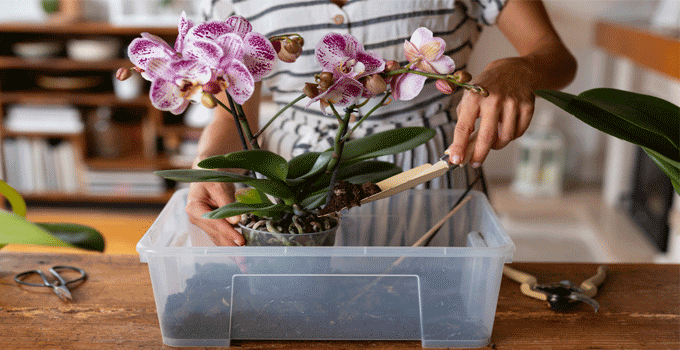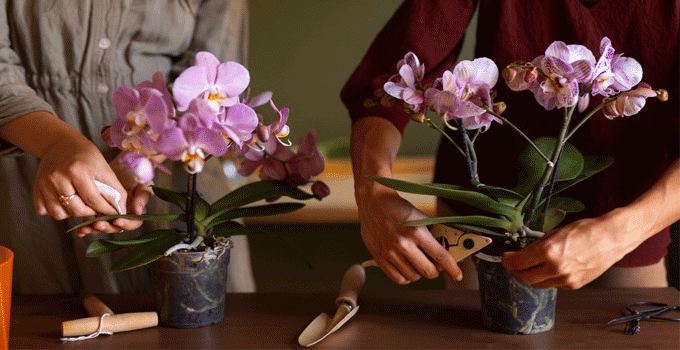How Do You Take Care Of An Orchid Plant?
From sowing and watering to lighting and repotting, this blog uncovers the practical tips on how do you take care of an orchid plant to keep it alive and flourishing. Ready to turn your home and garden into a tropical heaven? Let’s dig in.
Orchids are one of the most lively plants to grow in your home garden, both indoors and outdoors. With the proper environment and the right care, you get thriving and flourishing orchids with flowers all year long.
How to Care for Orchids?
Orchids are fragile plants. While these plants hold the reputation for being difficult, orchids can last over ten years when their water, light, soil, and fertilizer needs are properly met. Planning to plant an orchid? Follow the below-mentioned orchid care tips for a head start.

#1. Start with the Right Orchid
If you are new to growing orchid plants, Phalaenopsis, also known as the moth orchid, is your best bet. They’re the most common orchids found in stores and are relatively easy to care for.
What to Look for When Buying Orchid Plants?
- Healthy green leaves (without black or yellow spots)
- Firm roots that are silver or green
- Signs of pests or mold in and around the pot
Starting with the right orchid plant helps you set up for future orchid planting needs and care. It’s the first, and often overlooked, step in most of the guides on how to take care of a potted orchid.
#2. Give the Right Light
Orchids don’t like direct sun, but they are not very fond of the dark either. Place them near a windowsill where you get bright, indirect light for at least 4-5 hours, such as near an east-facing window.
Pro Tip:
- If the orchid leaves turn dark green, it’s craving for more light. If the leaves turn yellowish, they are getting too much.
- An easy way to remember this? Orchids love the light but not the heat. If it’s warm and sunny all-day, it’s too much light for your orchid.
#3. Water Wisely
This is where most orchid deaths happen. Overwatering drowns the roots while underwatering starves them. So, how do you take care of an orchid plant when it comes to watering? Follow the “Soak and Dry” Method:

How often should you water?
- Once a week is usually enough.
- Let the potting mix dry for about half of the potting medium.
- Stick your finger into the soil for about half of the pot. If it feels dry, water it.
- Remember to use room-temperature water always.
Avoid water sitting in the center of the leaves, as it can cause rot to the orchid roots. Tilt the plant slightly to drain out any water from the leaves after watering.
Do not forget to check if the potting medium has dried out before watering again. Think of orchids like they’re on a spa day—they enjoy the pampering but not the soggy towels.
#4. Master the Right Potting Mix
Orchids don’t grow in regular soil. They’re epiphytes. Meaning they grow in the wild on trees like moss. So when growing them indoors, you need a breathable, chunky mix.

Ideal Potting Mix for Growing Orchid Plants Includes:
- Bark chips
- Sphagnum moss
- Charcoal
- Perlite
If you’re wondering how do you take care of a potted orchid, remember a good airflow for healthy roots is vital. Repot and refresh the fertilizer mix once every 1 to 2 years, as the orchid plant roots need space to spread properly. It helps them prevent root rot.
#5. Temperature and Humidity Matter
Orchids like it cozy, just like us. Keep them in a space where temperatures range between 65°F and 75°F (18°C–24°C) during the day and about 10°F cooler at night.
Boost Humidity With:
- A shallow, humidity tray with pebbles and water
- A room humidifier
- Grouping plants together
Orchids generally prefer 40%–60% of humidity. So, if your home is dry, especially during winter, do not forget to give it a moisture boost.
#6. Fertilize Smartly
Every living being needs food to stay active and alive. Orchids are no different from other beings. A balanced, water-soluble fertilizer labeled “for orchids” will do the trick.
Use the “Weakly, Weekly” Rule:
- Mix fertilizer at one-fourth strength.
- Apply every week when watering.
- Skip feeding when your orchid is not actively growing or blooming.
Learning how do you take care of an orchid plant is knowing when to feed it and when to let it rest. Keep this in mind, and you will never have to worry about your orchid re-blooming year after year.
#7. Encourage Re-Blooming
So your orchid dropped its flowers. Don’t panic—it’s normal. Orchids go through dormancy after blooming.
Here’s How to Coax a Re-Bloom:
- Move it to a slightly cooler room at night.
- Reduce watering slightly.
- Keep it in bright, indirect light.
New flower spikes often emerge from the old ones. Trim the flower spike just above the node (the small bump) once all the flowers fall off.
#8. Keep Pests at Bay
Orchids are generally pest-resistant, but occasionally you may run into mealybugs (look like tiny cotton balls), spider mites, or scale insects.
How Do You Fix It?
- Wipe leaves with a damp cloth and mild soapy water.
- Use neem oil spray for natural protection.
- Isolate infected plants immediately.
Orchid care isn’t just about beauty; it’s also about vigilance. By keeping your plant pest-free, it can blossom indoors and outdoors with bright, beautiful colors.
#9. Pruning and Post-Bloom Care
Your orchid’s flowers have faded, now what? Many people toss the plant at this point, but don’t! With the right care after the blooming starts, orchids can and will rebloom.
Here’s how you can do it:
- Trim the flower tip slightly above a node to encourage another blooming season.
- If the spike turns brown or dries out, cut it out all the way down.
- Resume and refresh your usual care routine- light, water, and feeding.

These pruning steps prove to be quite important, if you’re wondering how do you take care of a potted orchid long-term, not just during the bloom phase.
How Do You Take Care of Indoor Orchids?
Taking care of orchids indoors involves understanding how to mimic their natural environment inside and outside your home.
Tips For Indoor Orchid Care:
- Use sheer curtains to filter light.
- Don’t let them touch cold window panes.
- If the humidity is low, mist the leaves in the morning
- Change the pot’s direction every week to ensure even light exposure to the whole plant
Indoor orchid care is all about balance: not too hot, not too cold; not too wet, not too dry. That’s the golden formula.
How Do You Take Care of a Potted Orchid Long-Term?
Over time, orchids need a little extra TLC. Knowing how do you take care of a potted orchid long-term means:
- Repotting every 18–24 months
- Trimming dead roots and leaves
- Keeping an eye on signs of stress (drooping leaves, no new growth)
- Regular check-ins go a long way. Just like any relationship, consistency builds health and trust—even with your orchid.
Time To Grow Your Orchids Like a Pro
Still thinking about the best orchid care tips without losing your mind or your blooms? Here’s the quick answer:
- Indirect light and good air circulation go a long way.
- Water once a week using the soak-and-dry method.
- Use orchid-specific potting mix.
- Keep the temperature and humidity consistent.
- Fertilize lightly and regularly.
- Don’t toss it after blooming; wait for it to come back.
Orchids aren’t difficult; they’re just different. And once you understand their language, you’ll be rewarded with exotic beauty that brightens your home and lifts your spirit, season after season.
Whether you’re a first-time plant parent or a seasoned gardener, using these practical orchid care tips will help you create the perfect environment for your plant to thrive. So, the next time someone asks about how do you take care of an orchid plant, you’ll know exactly what to say and show.


